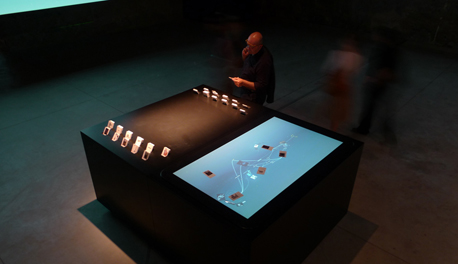background
The interactive installation “mæve” (MACE-Everyville) provides visual and tangible access to the social and intellectual networks behind architectural projects. The installation is part of the 11th International Architecture Exhibition of the Venice Biennale. It is on display from September 14th to November 23rd. The project is designed and developed by the Interface Design team of the University of Applied
Sciences Potsdam. At the Biennale, mæve connects the entries of the Everyville student competition and puts them into the larger context of MACE content and metadata. By placing physical project cards on an interactive surface, users can explore the presented projects, embedded in an organic network of associated projects, people and media.

interaction
The installation consists of an interactive surface and a large projection area. While users are interacting with the contents of the installation on the interactive surface, the network and the media files are displayed on the large projection.
The ten winning projects from the Everyville student competition are represented as physical cards. If a card is placed on the interactive surface, a contextual space is opened around the project. Within this space, media files, related projects and keywords are visualized. When a second card is placed on the surface, the space turns into a network
displaying similarities between the projects. In addition to the Everyville cards, the installation also contains inspirational projects from the MACE repositories. These projects are also represented by project cards and enable the visitors to connect the Everyville projects to MACE contents. Furthermore, as the interaction with the cards is not limited to the one person, entire groups and teams can explore the content together.

technology
The installation is realised in Java and uses the Processing and Gestalt frameworks.
For the card tracking, Reactivision 1.4 software is used. The interactive table was produced by Werk5 in Berlin.
For the card tracking, Reactivision 1.4 software is used. The interactive table was produced by Werk5 in Berlin.
































